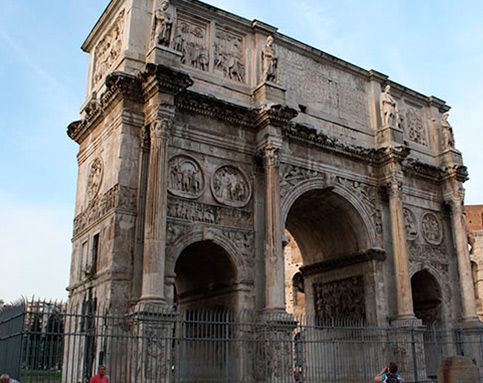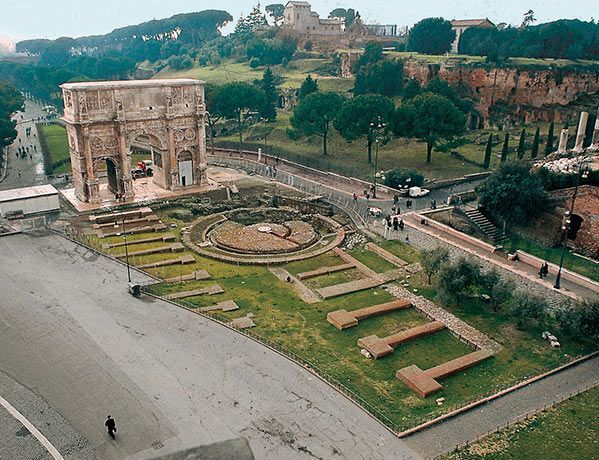Arch of Constantine
History of the Arch of Constantine
In ancient Rome, to celebrate great victories they would build triumphal arches in public places, such as main squares, for residents and visitors to see. Most of them have disappeared over the centuries, but three of them still stand today. One of them is the great Arch of Constantine, a triumphal arch located in the heart of Rome.
The Arch of Constantine marks the celebration of an important military victory. In 312 AD Emperor Constantine I defeated Emperor Maxentius, who occupied Rome, at the Battle of Milvian Bridge. This victory for Constantine helped to consolidate his power and eventually led to the Roman Empire’s conversion to Christianity. The triumphal arch was erected and dedicated to Emperor Constantine I, as a gift from the Senate of Rome to award him.
Frieze

The Arch of Constantine has a horizontal frieze below the round relief are the main parts of the time of Constantine. These historical reliefs are representations of scenes from the Italian campaign of the military victory over Maxentius, which was the main reason for the erection of the monument. The frieze begins at the western side with the departure from Milan, and continues on the southern face with the Siege of Verona on the left, an event that was of great importance to the war in Northern Italy. To the right, the Battle of Milvian Bridge is represented with Constantine’s army as victorious and the enemy drowning in the Tiber river. On the east side, Constantine and his army are entering Rome. On the north face looking towards the city are two strips with the emperor’s actions after taking possession of Rome. On the left, you can see Constantine speaking to the citizens, and to the right is the final panel with Constantine giving money to them.

Frieze
The Arch of Constantine has a horizontal frieze below the round relief are the main parts of the time of Constantine. These historical reliefs are representations of scenes from the Italian campaign of the military victory over Maxentius, which was the main reason for the erection of the monument. The frieze begins at the western side with the departure from Milan, and continues on the southern face with the Siege of Verona on the left, an event that was of great importance to the war in Northern Italy. To the right, the Battle of Milvian Bridge is represented with Constantine’s army as victorious and the enemy drowning in the Tiber river. On the east side, Constantine and his army are entering Rome. On the north face looking towards the city are two strips with the emperor’s actions after taking possession of Rome. On the left, you can see Constantine speaking to the citizens, and to the right is the final panel with Constantine giving money to them.
Architect and architecture

The architecture of the Arch of Constantine consists of a massive rectangular free standing structure that goes over 70 feet high. It has three arches; one large central arch with two smaller arches on the sides. The monument has Corinthian columns standing with their ornate decorative tops – called capitals – that reflect an architecture style developed in ancient Greece. The arch is decorated with carved sculptures and was built in a shot time period, where the builders reused parts of other structures and monuments.
Architect and architecture
The architecture of the Arch of Constantine consists of a massive rectangular free standing structure that goes over 70 feet high. It has three arches; one large central arch with two smaller arches on the sides. The monument has Corinthian columns standing with their ornate decorative tops – called capitals – that reflect an architecture style developed in ancient Greece. The arch is decorated with carved sculptures and was built in a shot time period, where the builders reused parts of other structures and monuments.

Dimensions

The Arch of Constantine stands about 20 meters high, 25 meters wide, and 7 meters in depth. It has three portals that punctuate the exceptional width of the arch, each one flanked by partially engaged Corinthian columns. The central opening is approximately 12 meters high, which has above two identical inscribed marble panels – one on each side – that read: “To the Emperor Caesar Flavius Constantinus, the Greatest, pious, fortunate, the Senate and people of Rome, by inspiration of divinity and his own great mind with his righteous arms on both the tyrant and his faction in one instant in rightful battle he avenged the republic, dedicated this arch as a memorial to his military victory.”

Dimensions
The Arch of Constantine stands about 20 meters high, 25 meters wide, and 7 meters in depth. It has three portals that punctuate the exceptional width of the arch, each one flanked by partially engaged Corinthian columns. The central opening is approximately 12 meters high, which has above two identical inscribed marble panels – one on each side – that read: “To the Emperor Caesar Flavius Constantinus, the Greatest, pious, fortunate, the Senate and people of Rome, by inspiration of divinity and his own great mind with his righteous arms on both the tyrant and his faction in one instant in rightful battle he avenged the republic, dedicated this arch as a memorial to his military victory.”
The Meta Sudans

The Meta Sudans, Latin for “sweating turning post”, was a large monumental conical fountain in ancient Rome. It was built between the Colosseum and the Temple of Venus and Roma, close to the later Arch of Constantine, at the main juncture of four regions of ancient Rome. The Meta Sudans were constructed between 89 and 96 AD, under the Flavian emperors, a few years after the completion of the Colosseum. It functions as a turning point, and marked the spot where a Roman triumphal procession would turn felt from the via Triumphalis along the east side of the Palatine Hill and onto the via Sacra, into the Roman Forum. The Meta Sudans is made from brick and concrete core, faced with marble. And you can still see the foundation visible from the circular region in front of the Arch of Constantine.
The Meta Sudans
The Meta Sudans, Latin for “sweating turning post”, was a large monumental conical fountain in ancient Rome. It was built between the Colosseum and the Temple of Venus and Roma, close to the later Arch of Constantine, at the main juncture of four regions of ancient Rome. The Meta Sudans were constructed between 89 and 96 AD, under the Flavian emperors, a few years after the completion of the Colosseum. It functions as a turning point, and marked the spot where a Roman triumphal procession would turn felt from the via Triumphalis along the east side of the Palatine Hill and onto the via Sacra, into the Roman Forum. The Meta Sudans is made from brick and concrete core, faced with marble. And you can still see the foundation visible from the circular region in front of the Arch of Constantine.

Facts

- The Arch of Constantine is a triumphal arch built in ancient Rome, located next to the Colosseum that still stands today.
- It was commissioned and built in 315 AD by the Roman Senate in honor to commemorate the victory of Constantine I over Maxentius at the battle of Milvian Bridge in 312 AD.
- The arch spans the Via Triumphalis, the main road taken by the emperors when they entered the city after a victory in triumph.
- The Arch of Constantine is one of the three remaining triumphal arches made in ancient Rome.
- It’s decorated with statues and reliefs, and the frieze depicting scenes of the battle and the entry of Constantine to the city of Rome.
- Although it was originally built for Constantine, sculptures and statues have been incorporated over the centuries to celebrate other victories, as well, like the ones of Marcus Aurelius, and also to represent hunting and sacrifice scenes from the time of Hadrian, nearly 200 years earlier.
- Although it’s among the most famous and recognized monuments of its era, it remains to be highly controversial due to several factors, including the fact that some historians claim it was built during the reign of Maxentius because the arch is decorated with parts of older monuments and depictions of Pagan gods and goddesses, despite Constantine’s inclination for Christianity.

Facts
- The Arch of Constantine is a triumphal arch built in ancient Rome, located next to the Colosseum that still stands today.
- It was commissioned and built in 315 AD by the Roman Senate in honor to commemorate the victory of Constantine I over Maxentius at the battle of Milvian Bridge in 312 AD.
- The arch spans the Via Triumphalis, the main road taken by the emperors when they entered the city after a victory in triumph.
- The Arch of Constantine is one of the three remaining triumphal arches made in ancient Rome.
- It’s decorated with statues and reliefs, and the frieze depicting scenes of the battle and the entry of Constantine to the city of Rome.
- Although it was originally built for Constantine, sculptures and statues have been incorporated over the centuries to celebrate other victories, as well, like the ones of Marcus Aurelius, and also to represent hunting and sacrifice scenes from the time of Hadrian, nearly 200 years earlier.
- Although it’s among the most famous and recognized monuments of its era, it remains to be highly controversial due to several factors, including the fact that some historians claim it was built during the reign of Maxentius because the arch is decorated with parts of older monuments and depictions of Pagan gods and goddesses, despite Constantine’s inclination for Christianity.